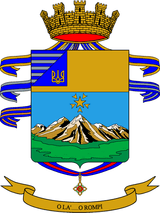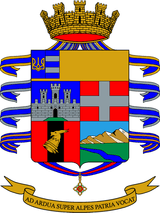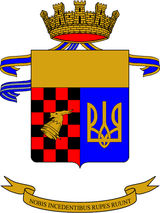3rd Alpine Division Julia
The 3rd Alpine Division Julia was a World War II light Infantry division of the Italian Army, specializing in Mountain Combat. The Alpini that formed the divisions are a highly decorated and elite mountain corps of the Italian Army comprising both infantry and artillery units. Today the traditions and name of the 3rd Alpine Division Julia are carried on by the Alpine Brigade Julia.
| 3a Divisione Alpina Julia | |
|---|---|
 Coat of Arms of the 3rd Alpine Division Julia | |
| Active | December 10, 1935 – September 8, 1943 |
| Country | Italy |
| Branch | Regio Esercito |
| Type | Alpini |
| Role | Mountain Infantry |
| Size | 17,460 men |
| Part of | Italian Alpine Corps 1942–1943 |
| Garrison/HQ | Udine |
| Engagements | World War II Greco-Italian War Italian War in Soviet Union |
| Commanders | |
| Notable commanders | Generale di Divisione Fedele de Giorgis |
Order of battle










- Conegliano artillery group
- Udine artillery group
- Val Piave' artillery group

- 207th Auto-Transport Battalion
- 415th, 416th Carabinieri Companies
- 628th, 629th, 633rd, 813th Field Hospitals
History
The division participated in the Greco-Italian War, entering action on 28 October 1940 in the Battle of Pindus, where it suffered heavy casualties. The division remained in line until 10 November, when it was withdrawn for reorganization, but after only four days it had to go into battle again, in the Perat sector, where it sustained heavy Greek attacks until 8 December. On 23 December the division was again attacked by the Greeks; the attack lasted till 31 December and forced "Julia" to retreat to Mali Qarishta, after heavy combat in extreme weather conditions. On 8 January 1941 a Greek offensive in the Berat sector hit "Julia" hard; on the following day the division had to retreat to Mali Tabajan, and by 21 January the division was down to a single regiment with three understrength battalions. The remains of the "Julia" were withdrawn to the Hani Bubesit area and then transferred to Mavrovo, near Vlorë, where the division was reformed. At the end of February the division, now 10,500 strong, was sent again to the first line; on 24 February it was deployed on Mount Golico and the Zagorias Valley. On 28 February a new battle was fought in the Tepelenë sector; the "Julia" Division, last Italian unit defending the town, was attacked by the 2nd Greek Division in the Dragoti area, but managed to hold the front while suffering heavy casualties. On 7 March the Greeks attacked on Mount Golico, and two days later they renewed their attack, causing heavy losses; by 11 March the Greek offensive ended without taking Tepelenë, and both the "Julia" and the two Greek Divisions involved in the attack (the 2nd and the 17th) were worn out by the heavy fighting and losses. In April 1941, following the German intervention and the fall of Greece, the division was transferred in the Corinth Canal area and occupied the Peloponnese.[1] During the Greco-Italian War the division had suffered overall 9,317 casualties: 49 officers and 1,625 soldiers during October-November 1940, 153 officers and 3,644 soldiers between December 1940 and January 1941, and 116 officers and 3,730 soldiers between February and April 1941.[2]
The division remained in Greece in garrison duty till March 1942, when it was repatriated to Italy in advance of its transfer to the Eastern Front as part of the Italian Army in Russia. On 28 March one of the troopships carrying the Division back to Italy, SS Galilea, was torpedoed and sunk by a submarine with the loss of 600 men from the "Gemona" Battalion. Its strength increased to 16,000 men, the "Julia" began its transfer to Russia on 14 July 1942, as part of the Alpine Corps (Corpo d'Armata Alpino) along with the 2nd Alpine Division Tridentina and the 4th Alpine Division Cuneense.[3] On 25 September 1942 the division was deployed on the Don river between Kuvshin and Karawut; on 11 December, in an attempt to stop the Soviet offensive, the division was transferred to the Ivanovka-Selenyj Jar-Novo Kalitva-Komaroff area.[4]
See also
- Italian Army in Russia
- Alpine Brigade Julia
References